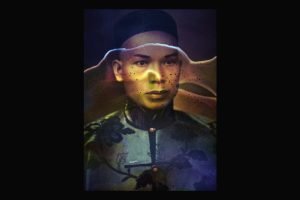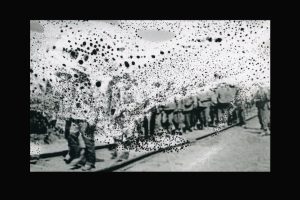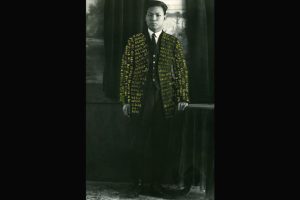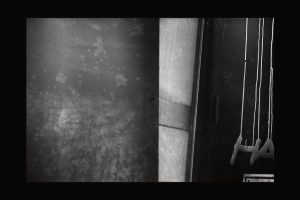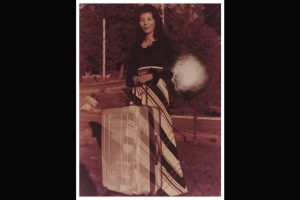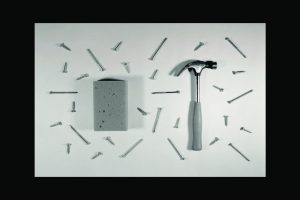
As part of the series "WE ARE IMMIGRANTS--The Hidden Hardships and Legacy of early Chinese Canadian immigrants", this image is a re-photograph of Leong Way's portrait (c.1900) which was created just before he left China for Canada in 1901. Leong Way operated a Chinese apothecary called BOW ON TONG in Lethbridge, Alberta where he helped many fellow Chinese citizens with new settlement. His efforts also helped to create a vibrant community in Lethbridge. BOW ON TONG was Leong's business as well as his family's home for over 100 years. To honour Leong's legacy, the re-photographed film was treated with Chinese herbal medicine before development.

This image is part of a series called "WE ARE IMMIGRANTS - The Hidden Hardships and Legacy of early Chinese Canadian immigrants". It is re-photographed using film that was subsequently burned. The image visually illustrates the stories of early Chinese migrants that helped build the most treacherous part of the Canadian Pacific Railway, thereby helping Canada solidify its confederation in 1867. The workers were tasked to carry nitroglycerin (an explosive used to break through the Rocky Mountains at the time) into caves to break ground. Many of them died namelessly as a result of this dangerous task.

This image is part of the series "WE ARE IMMIGRANTS - The Hidden Hardships and Legacy of Early Chinese Canadian Immigrants". It is a re-photographed image of Mr. Dan Wong who came to Canada in 1922, merely a year before the reinstatement of the Chinese Immigration Act (1923). This Act, intentionally reinstated to stop Chinese migration, separated Mr. Wong from his wife and his first-born son for 16 years. The words painted on Mr. Wong's jacket are a sample from a book of western etiquette that he carried with him. This book remains a family heirloom today.

"Irresolute Belonging" is a psycho-geographical exploration of a consciousness that merges a Chinese and Canadian existence. Utilizing analogue multiple exposures, spaces symbolic of the Chinese and Canadian cultures are captured to embrace the enigmatic psyche that strangely identifies with both and neither ethnicity at the same time.

"Pilot Astronaut" explores the experiences of Chinese mothers who migrated to the west between the 1970s and 1990s. These mothers migrated with their children while the fathers supported from Asia. Describing them as “astronauts”, sociologists distinguish these migrants from those earlier when men migrated alone. Astronaut migrants also differ from families that uprooted (or intended to) as a unit. The political landscape in Hong Kong and Taiwan prompted families to move for stability and education at a time when western governments promoted trade missions to attract Asian investors. Overwhelmingly, the astronaut strategy was for the benefit of the children. This is a re-photographed image of my mother (c.1973) appropriated with digital compositing and painting on colour film.

"Pilot Astronaut" explores the experiences of Chinese mothers who migrated to the west between the 1970s and 1990s. These mothers migrated with their children while the fathers supported from Asia. Describing them as “astronauts”, sociologists distinguish these migrants from those earlier when men migrated alone. Astronaut migrants also differ from families that uprooted (or intended to) as a unit. The political landscape in Hong Kong and Taiwan prompted families to move for stability and education at a time when western governments promoted trade missions to attract Asian investors. Overwhelmingly, the astronaut strategy was for the benefit of the children. This image expresses the typical yet incomprehensible nature of the astronaut family structure and how astronaut mothers dealt with day-to-day challenges.









